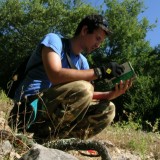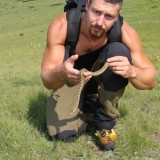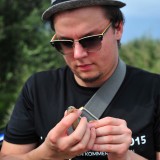
Dušan Jelić (PhD in Reptile Biology-Ecology) (1982) is President of Croatian Institute for Biodiversity. His work includes different aspects of Amphibian and Reptile research, like distribution, ecology, morphology, taxonomy, phylogeny, phylogeography, conservation, etc. He started his PhD in Reptile ecology (focusing on biogeography and species ecological niche overlap) in 2009 and has submitted his final thesis for evaluation in 2013. He worked for 5 years in State Institute for Nature Protection as expert for Amphibians and Reptiles and during this time he produced the second “Red book of Amphibians and Reptiles of Croatia” and worked as expert in designation of Natura2000 ecological network in Croatia (important sites for Amphibians and Reptiles). In 2009 and 2010 he also led the Amphibian and Reptile inventory project of the border river Una. During his career he was a project leader in over 10 biodiversity projects and some of the longest herpetofauna monitoring projects in Croatia: 6 year (2007-2012) long project for inventory and monitoring of Vipera ursinii macrops, 4 year (2009-2012) long project for distribution mapping and monitoring of Ablepharus kitaibelii. In 2012-2013 he was engaged as key expert for herpetofauna on MANMON project for NATURA2000 menagement and monitoring in Croatia. He is editor in charge of journal HYLA – herpetological bulletin, reviewer in 3 other herpetological journals, author of 5 books and 16 scientific papers dealing with Fish, Amphibians and Reptiles. He attended many scientific congresses mostly with talks (13) or posters (3).

Benjamin Jusić was born the 07.09.1982. in Munich. From early childhood he developed passion to herpetofauna and after years of working in teraristics, he decided to officially devote to research of amphibians and reptiles. In 2006 he moved to Mostar (BiH), where he started biology studies at the University "Džemal Bijedić" were he holds a masters degree. Many years of work with snakes resulted in his bachelor thesis (Diversity of ophidiofauna in Herzegovina" and master's thesis (Sexual dimorphism and morphological variability of Vipera ammodytes species in Herzegovina). Benjamin's field work is presented through several scientific papers and posters. He participated in many projects throughout the region from Croatia to Macedonia. His narrow specialty is Ophidiofauna (snakes) with special emphasis on Viperidae. He is engaged for more then 15 years in work with poisonous snakes and managing reptiles in captivity. In the year 2014 he joined BHHU: ATRA to support the development of research of herpetofauna in BiH and the region.

Mirza Čengić was born the 17.02.1989 in Sarajevo, Bosnia & Herzegovina. Currently, his main interests are spatial ecology, conservation biology and usage of multi-disciplinary approach of earth observation data, GIS (Geographical Information System) and modelling, to answer questions in conservation and ecology, particularly related to the biodiversity of amphibians and reptiles. Aside this, his interests include nature, mountains, drums and loud music. He finished undergraduate (bachelor) studies in Biology in 2013 at University of Sarajevo, where he worked on his final thesis that focused on the development of GIS database for amphibians and reptiles of Bosnia & Herzegovina. During the bachelor studies, he was involved in various projects conducted by the Association of Biology Students (DSB), and BHHU ATRA. He finished his master degree in Geo-information science and earth observation for environmental modeling and management in the year 2016 at Lund University (Sweeden) and in ITC, University of Twente (Netherlands). His master thesis topic involved assessing the representitavness of Natura 2000 network for protection of amphibians and reptiles of Crete (Greece), which was done using species distribution models and gap analysis. He is a co-author of several papers in the domain of herpetology and co-author of one book in this field. He currently works for the Department of Environmental Science at Radboud University in Nijmegen, where he works to further develop environmental assessment models designed to quantify human impacts on wildlife and biodiversity.